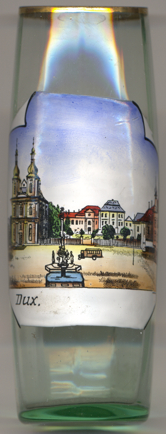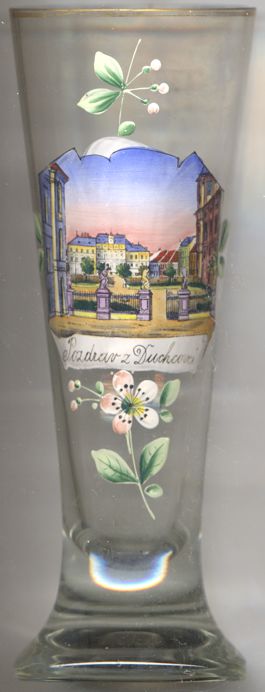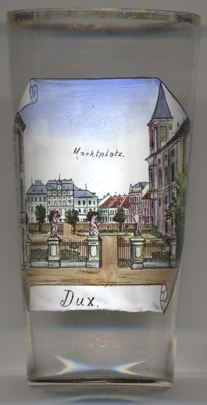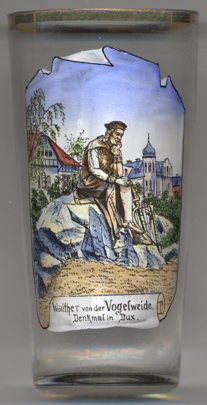

|
| ČESKÁ REPUBLIKA | CZECH REPUBLIC |
| Ústecký kraj | Ústí nad Labem region |
| Okres: Teplice |

 Duchcov (previously in German: Dux) is situated at an elevation of 201 nm in the foothills of the
Krušné hory (Ore Mountains, Erzgebirge) mountion region of northwestern Bohemia, about 8 km southwest
of the district town, Teplice. The municipality has a population of about 8,500 (2019).
Duchcov (previously in German: Dux) is situated at an elevation of 201 nm in the foothills of the
Krušné hory (Ore Mountains, Erzgebirge) mountion region of northwestern Bohemia, about 8 km southwest
of the district town, Teplice. The municipality has a population of about 8,500 (2019).
The oldest written document mentioning Tockczaw dates from 1240; later documents mention it as Duchczow and Dux. The German population increased especially from the mmid-14th century onwards. In 1412 it became a property of the Bohemian Crown, but in 1417 it had to be ceded to the margraviate of Meißen, but in 1459 with the Treaty of Eger (Cheb) finally became part of Bohemia. The privileges as a town were confirmed in 1460. In 1527 the Duchcov estates were sold to lords (1623 princes) of Lobkowitz (Lobkovic). In 1642 it came in possession of the counts of Waldstein (z Valdštejna). After the end of manorialsm, Dux became an independent municipality in 1850. After Worls War I Duchcov became part of the Czechoslovak Republic. Occupied by Nazi Germany between 1938 and 1945, it was liberated in 1945 and the German population was expelled in the same.
The  deanery church of the Annunciation of Our Lady [left, no. 3701: left]
stands on the site of a previous, Renaissance church of 1587, which, however, itself had replaced an earlier church of the
Gothic and previous periods. The church was rebuilt in baroque style first in 1696–1707 by the architect Marc
Antonio Canevalle, finally completed until 1721 and was consecrated in 1722. The church was restored in 1826. In 1945, the
church was burnt down by the Soviet army, destroying all of its interior decorations.
deanery church of the Annunciation of Our Lady [left, no. 3701: left]
stands on the site of a previous, Renaissance church of 1587, which, however, itself had replaced an earlier church of the
Gothic and previous periods. The church was rebuilt in baroque style first in 1696–1707 by the architect Marc
Antonio Canevalle, finally completed until 1721 and was consecrated in 1722. The church was restored in 1826. In 1945, the
church was burnt down by the Soviet army, destroying all of its interior decorations.
 Duchcov château [left, no. 3701: background centre] was founded
as a fort in the 13th century by the Hrabišič family, which resided at Osek. Not earlier than 1527 the
Lobkowicz family replaced the fort with a one-wing Renaissance palace. Since 1642 it was in possession of the counts of
Waldstein (in Czech: Valdštejnové). The castle was then rebuilt in 1675–1685 by the French architect
Jean Baptiste Mathey who designed a huge Baroque complex including a large park and a hospital. The decoration of the
building was provided by the best Baroque artists in Bohemia, like the sculptors Matthias Bernhard Braun,
Ferdinand Maxmilian Brokoff, and painter Wenzel Lorenz Reiner. Between 1785 and 1798, Giacomo Casannova
spent the last thirteen years of his life in Duchcov as librarian of the count of Waldstein. In the 19th century,
the château was rebuilt in the classicist style and the garden in the romantic style. The Waldstein family left the
place in 1921. At present, the château is state-owned and open to visitors. The garden grounds serve as a public park.
Duchcov château [left, no. 3701: background centre] was founded
as a fort in the 13th century by the Hrabišič family, which resided at Osek. Not earlier than 1527 the
Lobkowicz family replaced the fort with a one-wing Renaissance palace. Since 1642 it was in possession of the counts of
Waldstein (in Czech: Valdštejnové). The castle was then rebuilt in 1675–1685 by the French architect
Jean Baptiste Mathey who designed a huge Baroque complex including a large park and a hospital. The decoration of the
building was provided by the best Baroque artists in Bohemia, like the sculptors Matthias Bernhard Braun,
Ferdinand Maxmilian Brokoff, and painter Wenzel Lorenz Reiner. Between 1785 and 1798, Giacomo Casannova
spent the last thirteen years of his life in Duchcov as librarian of the count of Waldstein. In the 19th century,
the château was rebuilt in the classicist style and the garden in the romantic style. The Waldstein family left the
place in 1921. At present, the château is state-owned and open to visitors. The garden grounds serve as a public park.
The Baroque  Trinity column [left, no. 3701: foreground centre]
was created in 1750–1760.
Trinity column [left, no. 3701: foreground centre]
was created in 1750–1760.
Another glass of this collection shows the Walther monument in
Bolzano/Bozen in South Tyrol, Italy.
[https://de.wikipedia.org/wiki/Duchcov, https://cs.wikipedia.org/wiki/Duchcov;
https://cs.wikipedia.org/wiki/Kostel_Zvestování_Panny_Marie_(Duchcov);
https://en.wikipedia.org/wiki/Duchcov_Chateau, https://cs.wikipedia.org/wiki/Duchcov_(zámek);
https://www.wikiwand.com/de/Heinrich_Karl_Scholz;
https://www.wikiwand.com/en/Walther_von_der_Vogelweide]
 Glass no. 4457 [near left] shows another view of the central sqaure of Duchcov, here looking from
the château (this would be in your back) to the other end of the market square with town houses in the background
and the church of the Annunciation (se above) now depicted on the right.
Glass no. 4457 [near left] shows another view of the central sqaure of Duchcov, here looking from
the château (this would be in your back) to the other end of the market square with town houses in the background
and the church of the Annunciation (se above) now depicted on the right.
 the
the  monumment for Walther von der Vogelweide was created in 1911 by the sculptor
Heinrich Karl Scholz. Walther von der Vogelweide was a Minnesänger who composed and performed love-songs and political
songs in Middle High German. Walther has been described as one of the greatest German lyrical poets; his hundred or so
love-songs are widely regarded as the pinnacle of Minnesang, the medieval German love lyric, and his innovations breathed
new life into the tradition of courtly love. He is also the first political poet writing in German, with a considerable
body of encomium, satire, invective, and moralising.
monumment for Walther von der Vogelweide was created in 1911 by the sculptor
Heinrich Karl Scholz. Walther von der Vogelweide was a Minnesänger who composed and performed love-songs and political
songs in Middle High German. Walther has been described as one of the greatest German lyrical poets; his hundred or so
love-songs are widely regarded as the pinnacle of Minnesang, the medieval German love lyric, and his innovations breathed
new life into the tradition of courtly love. He is also the first political poet writing in German, with a considerable
body of encomium, satire, invective, and moralising.
![[scale]](lineal.jpg)